Home » Small Game Cooking » How to Butcher a Wild Turkey
How to Butcher a Wild Turkey

Jack Hennessy grew up in the South Suburbs of Chicago…
Learn the best practices for butchering, carving and cooking your wild spring turkey
When people most people think of turkey, domestic or wild, they envision a whole bird. The skin is crispy, caramelized from a long oven roast, and stuffed to the brim as a dinner table centerpiece. This was the picture I had in my mind when I bagged my first wild turkey over 12 years ago. I treated it no differently than a Thanksgiving bird. Upon trying to carve and bite into the thighs, I immediately realized that one does not simply roast a wild turkey whole.
Listen to more articles on Apple | Google | Spotify | Audible
While I still know alleged wild game chefs that do this and proclaim it works based on XYZ, I think they’re spitting on my cupcake and telling me it’s frosting. The truth is that wild turkey meat can taste incredible if you know how to butcher and cook it correctly.
Here is how it’s done.
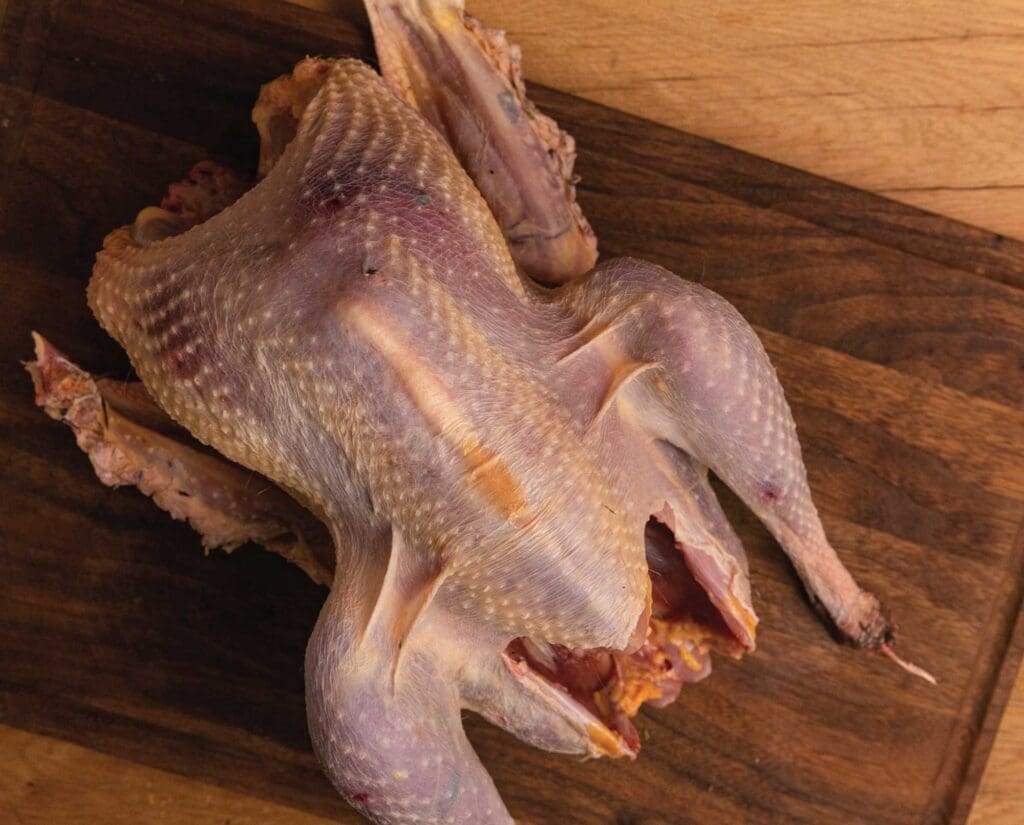
Do I Pluck or Skin a Wild Turkey?
In past articles, I advocate for plucking when possible. Additionally, I have suggested not gutting the bird before plucking, as tears in the skin may make plucking difficult. In the instance of wild turkeys, based on the toughness of the skin, you can indeed gut the bird before plucking. Additionally, because these large birds are heavily insulated and hold a lot of heat, you’ll want to gut that bird within a couple of hours, especially if the day is supposed to be a warm one.
And, yes, you should absolutely save your giblets. More on that here.
Wild turkey skin has flavor, but wild turkey is one of those birds where I don’t consider plucking to be essential. In terms of the wings, though, plucking those is worth the effort. This is because of the skin-equals-flavor argument and because skinning (e.g., knife work) along the wings runs the risk of damaging meat.
But the thighs and legs require low-and-slow cooking techniques. When using these methods, the skin may turn into gelatin and actually offer an unwanted texture in your wild turkey dish. Regarding the breasts, skinning or plucking them is up to you. In the butchering section, I’ll explain why the effort of plucking wild turkey breasts may not fit your needs in the kitchen.
If you do plan to pluck your bird, you can dry pluck or scald it, which means dunking the whole bird in 150-degree Fahrenheit water multiple times until the wing feathers easily pull out. Once they do, you’re ready to pluck the rest of the bird. Remember that it might take three to five minutes of dunking for the wing feathers to pull out easily.
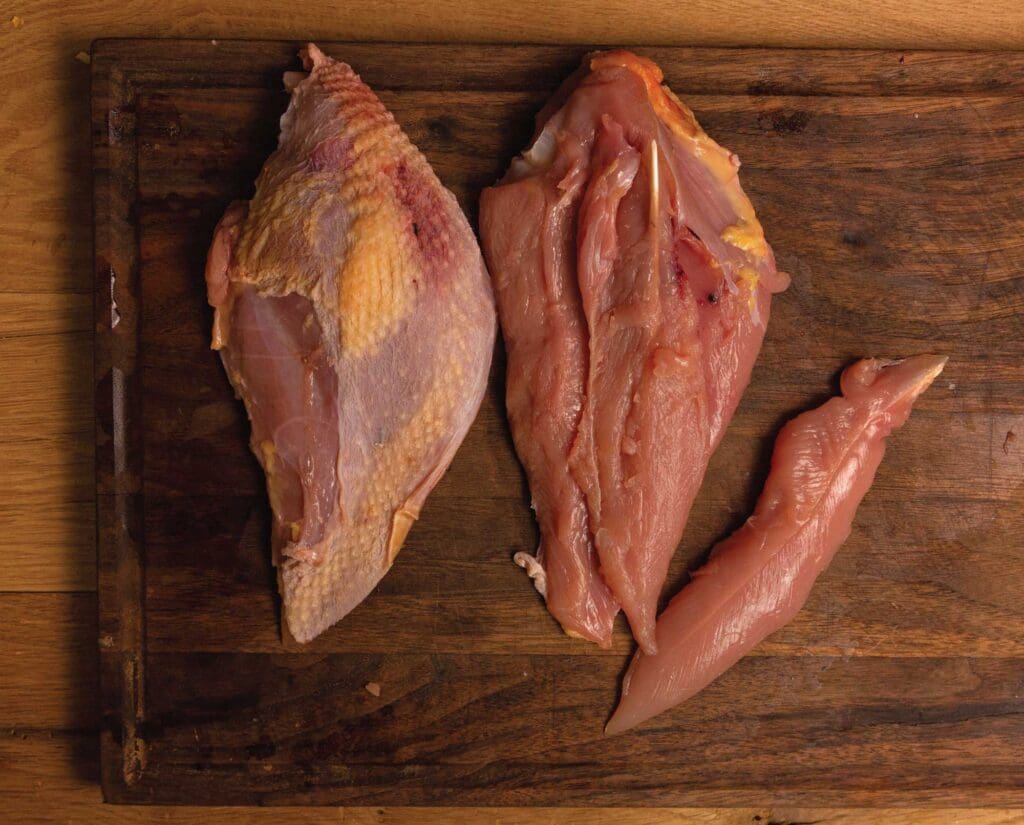
Butchering Wild Turkey Breasts
Before you remove your turkey breasts, make sure your knife is razor sharp and, ideally, somewhat flexible. You’ll want to use a fillet knife or something similar to remove turkey breasts. (Read: do not use a carving or chef knife as you might use at the Thanksgiving table.) You don’t even need a long knife; a sharp pocket knife will serve you well.
When butchering my wild turkeys, I start by removing the breast meat. You can pluck or skin them, but it helps to cut the loose skin between the thigh and breast, then fold the thighs before proceeding (or remove the thighs completely before the breasts, up to you). Next, make an incision to either the left or right of the keel bone, just below the wishbone, with the bird’s feet pointed toward you. Keep the blade tight to that keel bone as you run your knife down to its base. From there, it’s a matter of angling your blade to free the meat from the bone via gradual swipes. To do so, place your index finger along the back of the unsharpened side of the blade to help steer the edge up toward the wings. With your non-knife hand, pull the breast meat up and away from the bone, so your knife can get underneath the meat and continue to work inhibited. The contour line of the bone below the breasts isn’t flat, so go slow and angle your blade so it carves off every morsel of meat from the bone.
As you work, you may turn the bird so the head faces me instead of the feet. This helps as I work the blade along the side of the turkey, up towards the shoulder joint. Once you reach the shoulder joint, return to the keel bone and follow the line along the wishbone, eventually meeting at the shoulder and pulling the breast. Repeat these steps on the other side.
Turkey breasts are enormous. Each breast may be the size of your head. When cooked whole, a wild turkey breast’s outer layers often dry out before the center hits that 150 temp. For this reason, I suggest butchering breasts into smaller portions, approximately eight ounces each. When cutting up these portions, it may help to butterfly the breast, or cut it in half like you’re opening up a book. From there, carve it into pieces resembling a chicken breast’s size and shape.
Because of the need to butcher wild turkey breasts into smaller portions, plucking turkey breasts is not worth it to me. Even if you pluck the breasts, you’ll end up with several skinless pieces anyways.
Butchering Wild Turkey Tenderloins
The tenderloins are that smaller, finger-like piece of meat hidden below the breasts. They have different muscle striations and should be cooked separately. On a large spring gobbler, they can be the size of a pheasant breast. As you might have guessed, they are the most tender cut on a wild turkey. You shouldn’t need a knife to remove them; you can carefully peel turkey tenderloins off the bone.
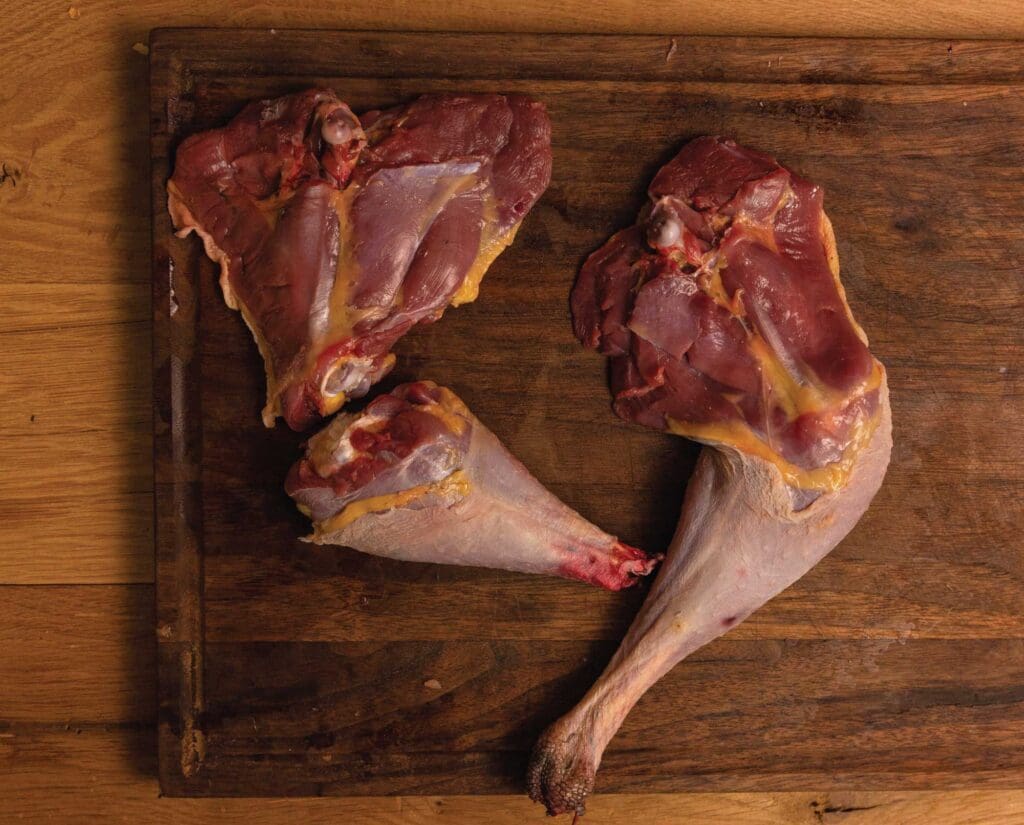
Butchering Wild Turkey Thighs and Legs
I skin turkey legs and thighs, which means I make a small incision in the skin on both thighs to rip it open and pull the skin off the thighs. Next, I fold the thighs backward, popping the socket-shaped bones from the hip joints. Using my knife and concentrating on starting as far back as possible, I start cutting towards the base of the back of the bird. This helps to remove as much thigh meat as possible. Continuing to fold the thigh backward might help you as you cut, too. Doing so will show you which line to follow.
Once the thigh is freed from the bird’s body, pull off any remaining skin. Roll the base of the leg at the foot joint, attempting to crack that joint and remove the feet. If you’re separating the thigh from the turkey leg, carefully roll the leg back and forth at the thigh joint. Once it’s loose, use your knife to sever the tendons.
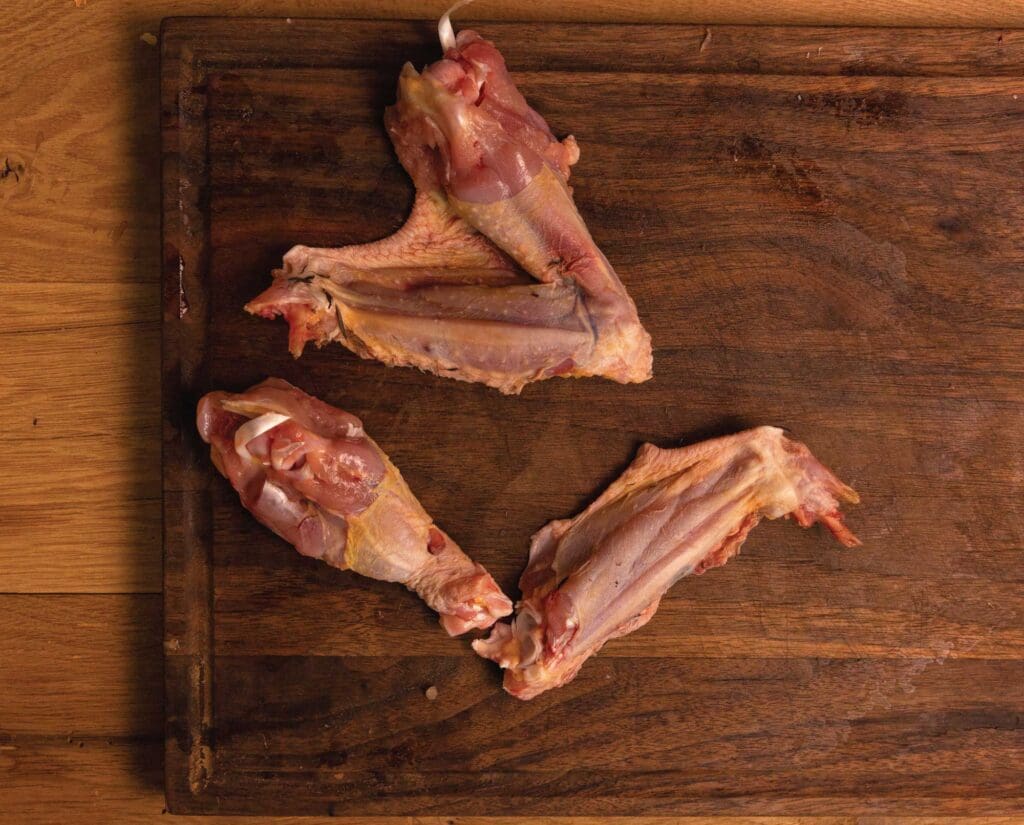
Butchering Wild Turkey Wings
It’s easier to butcher wings if they have been plucked. If you’re dry plucking, this may take some muscle and patience, but it’s more than possible to pluck the wings within ten minutes.
If you’ve already removed the breasts, you should be able to see the wing shoulder joints. Pop them upward as if the bird is attempting to fly. Use your knife to carve around the joint, somewhat back into the bird’s cavity, to free the wing. Unlike thighs, which follow a straight line when cutting them away from the body, wings require you to make a half circle with your knife edge back toward the breast bone.
After removing a wing, you can separate it at the drumette joint or keep it whole. If you’re separating it, just like the thigh and leg, carefully rock that joint back and forth until it loosens; toughly handling joints runs the risk of mangling meat. Then sever any remaining tendon or skin connections.
Wild Turkey Giblets
Cut off your turkey’s neck to include it in gravy or stock. If you pluck the bird’s back, you can cut out the spine to use in stock or gravy using a pair of kitchen shears. There might be meat tucked underneath the wishbone, too. Using those same shears, cut off the wishbone and either peel off the meat or save it whole to cook that little bit of meat on its own. You can also save the liver, gizzard, and kidneys from your turkey.
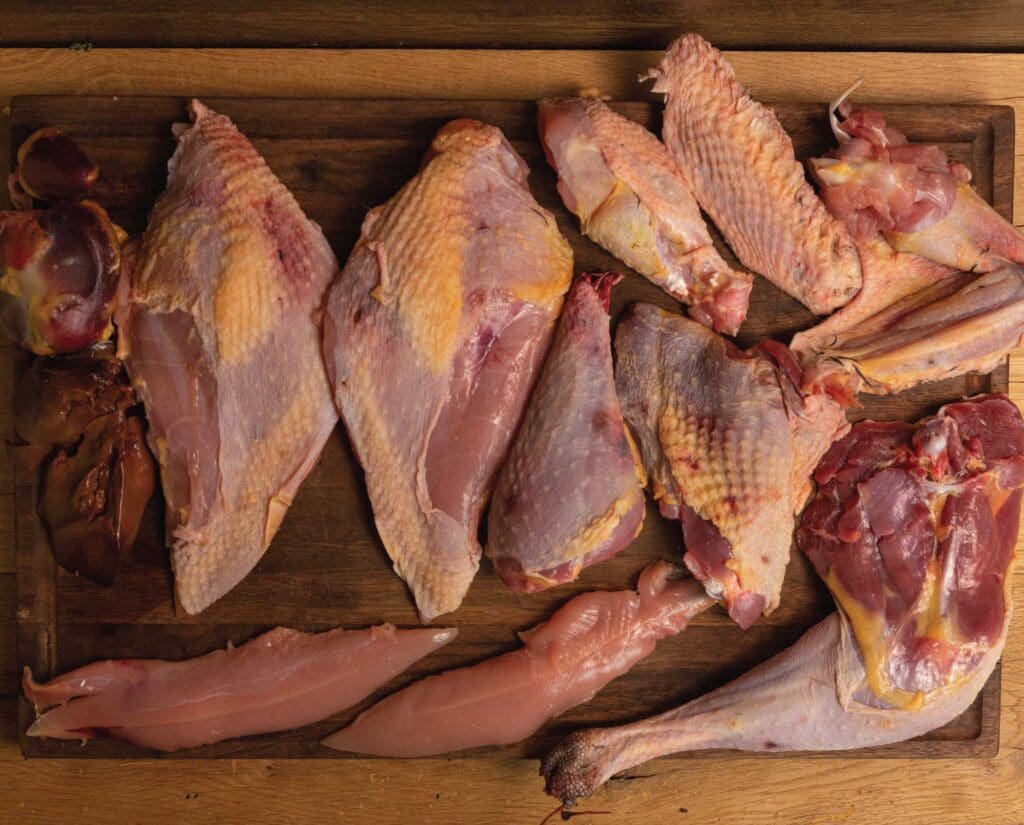
How to Cook Wild Turkey Cuts
Before you cook any part of your wild turkey, brine your cuts. Here’s how to brine wild bird meat. Next, understand this is a wild, lean, and old bird compared to domestic turkeys. For context, chickens are killed and butchered when they’re seven to nine weeks old. You likely killed at least a 2-year-old wild turkey.
Avoid cooking the breast whole unless you’re smoking it low and slow for a while (or a similar technique where low heat can move more evenly through the meat).
Collagen is prevalent in the working cuts, including the wings, thighs, and legs. Collagen will toughen up before it tenderizes. This is why you need to cook these tougher cuts via low-and-slow methods. Here’s a recipe for BBQ Wings, and you can apply these same cooking methods to turkey thighs and legs. There are other great turkey recipes on Project Upland’s website, so scroll through and find something that sounds delicious. I’ll have more recipes to follow this butchering guide, too, once I shoot my own spring gobbler this year.
For more general wild-turkey handling and cooking tips, check out this article.
Reach out to me on Instagram (@WildGameJack) with any questions or comments.
Jack Hennessy grew up in the South Suburbs of Chicago and didn't start hunting until he attended graduate school in Spokane, Washington, at the age of 26. Hennessy began work in professional kitchens in high school but didn't start writing wild game recipes until he joined the Spokesman-Review in 2014. Since then, his recipes have appeared with Petersen's Hunting, Backcountry Journal, Gun Dog Magazine, among many others. He now lives with his Wirehaired Vizsla, Dudley, in Wichita, Kansas.

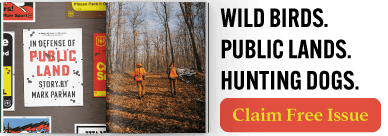


So you don’t hang your turkey til rigor is over? I read that somewhere, that if you hang your turkey for 3-6 days, the feathers are easier to pull without having to scald, which we have found to be true. Why or why not? And I’m not trying to be a smart butt here, I’m genuinely interested. I don’t know that much about wild turkeys. I’ve only had experience with one, and it was a disaster. We had zero idea of what we were doing. We have one hanging right now, courtesy of a hunter we let shoot on our property. We’re in the mountains and it’s still cold right now.
great question about hanging the turkey before butchering. I eviscerate, then hang them about 5 days in a cooler (<40 def) and we've found it greatly improves the flavor. Whether you should pluck or skin the bird, I have no opinion. I skin and parcel up the breasts, wings, and legs. But aging the bird is key.